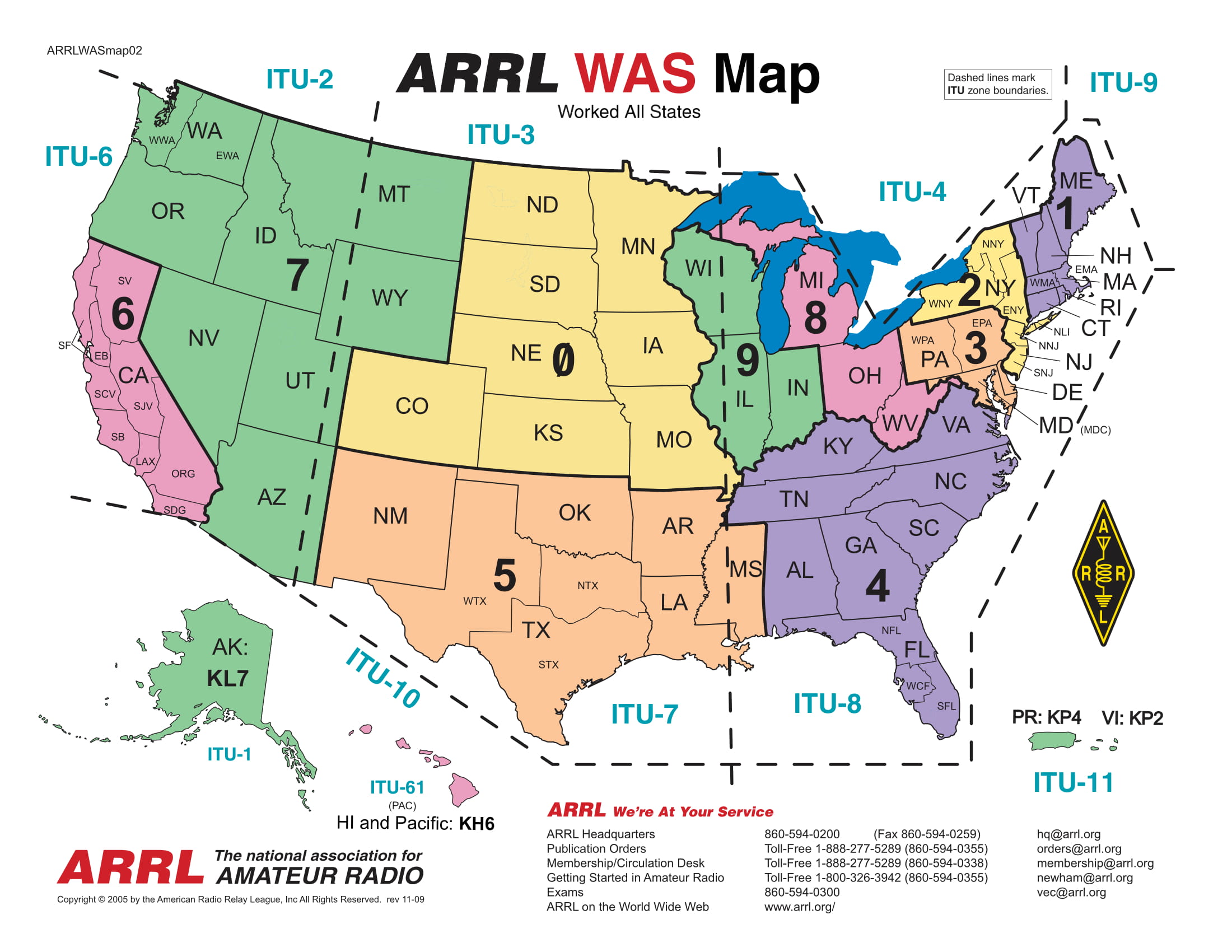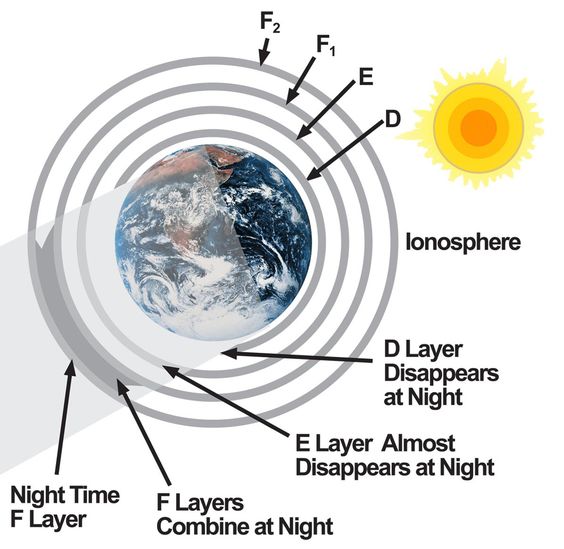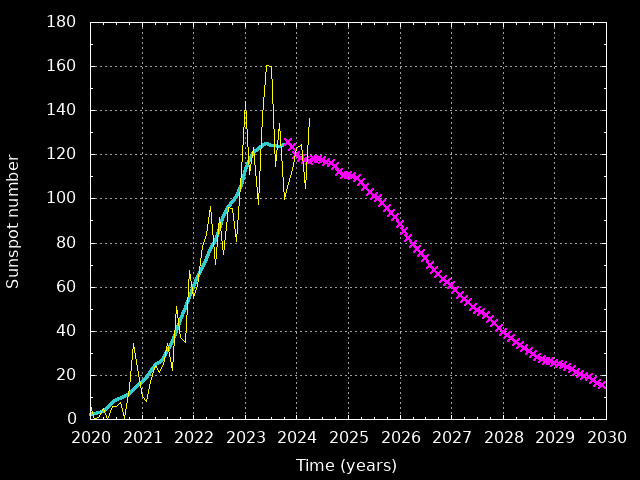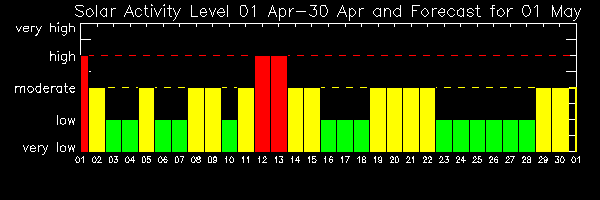| Solar Indices and their effect upon HF Propagation |
| Comm Path → |
Factors for All Comm Paths |
|
Added factor for
Polar Paths |
| Solar Index
(Define) →
|
Solar Flux [SFI]
Sunspot Num [SN] |
K-Index [K], A-Index [A]
Solar Wind Speed [SW]
Mag Field Vector [Bz] |
X-ray Solar Flares
[X-Ray] |
|
10-MeV
Proton Flux [Pf] |
| Physical Effect → |
Improves F-Layer Ionization |
Solar Wind disturbs Magnetosphere
creating Geomagnetic Storm |
Ionizes Sun-lit Side
D-Layer |
|
Ionizes Polar D-Layer |
| HF Radio Effect → |
Improves Refraction
of F-Layer + Sets MUF |
Broadband RF Noise
(Sets the Receive Noise Floor) |
Signal Attenuation |
|
Polar Path Attenuation |
|
|
Extreme |
SFI = 200-300
SN = 160-250
Reliable Comms
160-6m |
K = 9, A = 300-400 (400)
Noise S30+, No Comms |
X20
Blackout
Entire Sunlit Side
for hours |
|
105
Full Blackout |
| Severe |
K = 8, A = 200-299 (208)
Noise S20-30, Comms sporadic |
X10
Blackout
Most of Sunlit Side
for 1-to-2 hours |
|
| Strong |
SFI = 150-200
SN=105-160
Excellent Comms
160-10m + 6m openings |
K = 7, A = 100-199 (132)
Noise S9-S20, Comms intermittent |
X1
Wide-area Blackout
about an hour |
|
104
Partial Blackout |
| Moderate |
SFI = 120-150
SN = 70-105
Fair-to-Good Comms
160-10m |
K = 6, A = 50-99 (80)
Noise S6-S9, QSB higher lats |
M5
Limited Blackout
tens of minutes |
|
1000
Degraded Comms |
| Minor |
SFI = 90-120
SN = 35-70
Fair Comms
160-15m |
K = 5, A = 30-49 (48)
Noise S4-S6, QSB higher lats |
M1
Occasional loss of Comms |
|
100
Small Effect |
| Active |
SFI = 70-90
SN = 10-35
Poor-to-Fair Comms
160-20m |
K = 3-4, A = 8-29 (15,27)
Noise S2-S3, Minor QSB higher lats |
C1
Low absorption |
|
10
Minor Effect |
| Normal |
SFI = 64-70
SN = 0-10
Bands Closed
above 40m |
K = 0-2, A = 0-7 (0,4,7)
Noise S0-S2, No Effect |
A1-B9
No Effect |
|
1
No Effect |
Official Update Period →
(web data more frequent) |
SFI = 3x/day
SN = daily |
K = 8x/day, A = daily
SW = Bz = Hourly |
X-Ray = 8x/day
| |
Pf = hourly |
Current Data →
↓
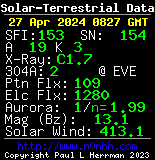
(Refresh page to update)
|

|
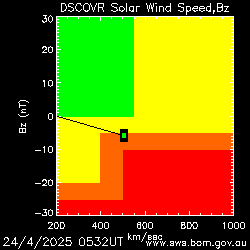
Graphic K-Index Estimate
Roughly plots K-Index as a function
of Solar Wind Speed (SW), Magnetic
FieldVector (Bz), and Solar Wind
Density. Dot Density: grn=low, yel>10,
red>15 pt/cm3. (10 minute updates)
|

↑
X-Ray Flux
Recovery after event:
X5.0 -> 120 minutes
X1.0 -> 60 minutes
M5.0 -> 40 minutes
M1.0 -> 25 minutes
|
|

Proton Flux Data
units in pfu (particle flux unit = particles / cm2-s-sr)

↑
30 MHz Polar Absorption
D-Region Absorption Plot
|
| Predicted Data →
|
SFI + SN Predictions
Cycle-25 Progression.
Past SN Cycles>
|
3-Day K Forecast
|
| |
|
In a Nutshell: Ionospheric Layers for the HF User
The ionosphere is formed as a consequence of the sun's radiation ionizing Earth's atmosphere - it changes significantly with time of day (solar radiation) and sunspot activity. For HF users, only 2 ionospheric layers are our primary concern - that is, the D-Layer and the F-Layer (see diagram).
The D-Layer is the lowest layer, affecting the bands below 20 meters. It is absorptive, attenuating signals as they pass. It is NOT our friend. The D-Layer forms by the sun's radiation during the daylight hours
and disappears immediately after sunset. It is not affected by sunspot activity. Hence, expect only local signals during the day and better DX after sunset.
The AM Broadcast, 160 meter, and 80 meter bands are greatly attenuated by the D-Layer - daytime
DX is impossible. The 40 meter band is affected to a lesser extent - the relatively short path of a vertically radiated
NVIS signal will generally pass through the D-Layer with far less attenuation.
Otherwise, signals radiating in a more horizontal direction, seeking DX, will be within the D-Layer a greater
distance, greatly attenuating the signal. The D-Layer has no effect on the 20 meter band and up.
The F-Layer, on the other hand, is our friend. It acts as a refractive layer for our signals. Like the D-Layer,
the F-layer forms from the sun's radiation, but it's refractive ability persists for many
hours after sunset. The F-Layer is the strongest during the solar peak years - expect this cycle to last through 2026.
In Summary: At High-HF, DX signals are refracted by an F-Layer that is strong all day and can last into the evening. Solar activity affects the stength of the F-Layer. At low-HF, the disparity between the absorptive D-Layer
dissipating immediately after sunset and the delay of the refractive F-Layer to dissipate much later in the
evening offers a predictable window of opportunity for DX.
This short treatise discusses neither the E-Layer nor the F1 and F2 sublayers.
They are immaterial to this application and are topics for further study.
|
Expected Propagation for each HF Amateur Band
HF signal propagation can be long-range via skywave, or short-range via ground-wave or line-of-sight.
The HF frequency, either high or low, has a big effect on how the signal propagates through the ionosphere.
The F-Layer refracts all HF signals daily and into the evening, but during sunlight hours low-band HF signals are
unable to penetrate the D-Layer and are limited to a short ground-wave range.
Executive Summary
- The 20m band generally works both day and night.
- Lower frequencies work best at night.
- Higher frequencies work best during the day.
- The farther from 20m you are the more pronounced the effect.
- Space weather is quite variable, so expect exceptions.
Band descriptions
160 Meters (1.8-2.0 MHz): This "top band" and the AM Broadcast band, located just below, have similar propagation. Daily D-Layer absorption limits groundwave propagation to around 75 miles. At night, the D-Layer goes away, with summer nighttime ranges of several hundred miles - in winter, several thousand miles. Summer operations are sparce due to static crashes from lightning storms, but winter evenings can yield clear DX.
80 Meters (3.5-4.0 MHz): Similar to 160 meters, daily D-Layer absorption limits propagation to around 100 miles via ground wave. At night, the D-Layer disappears yielding ranges over 1000 miles. This band tends to provide consistent propagation subject to variations of the solar cycle. Hence, scheduled nets and ragchewing are popular. To a lesser degree than 160 meters, this band is frequently noisy with summertime static crashes. Some folks refer to the CW end of the band as "80-meters" and the phone portion as "75-meters."
60 Meters (5.332-5.405): A cluster of 5 channels we share as a secondary user with the government. Restrictions apply for mode, frequency, power and antenna gain. This band shares the propagation characteristics of 80 and 40 meters.
40 Meters (7.0-7.3 MHz): A VERY popular daytime NVIS band with distances out to 500 miles - at night the band goes long, with distances of 800 miles or much more. Its regional range consistency makes scheduled nets and ragchewing popular. At night, some higher frequencies on this band are occupied by foreign broadcasters.
30 Meters (10.10-10.15 MHz): A small CW-and-Data-only band, with propagation like 40 meters, but with a slightly longer DX range out to 1000 miles. There is no broadcast interference. We share this band as a secondary user and have a 200 watt power limit.
20 Meters (14.00-14.35 MHz): The most popular daytime DX band - the D-Layer has no effect here. During the day, stations 1000-to-1500 miles are usually present, while good conditions will also yield stations at 2000-to-3000 miles - a good band to span the US. At night, during solar minimums the band is dead, but at solar peak the band may remain open. Ground wave range is minimal.
17 Meters (18.068-18.168 MHz): A small band with fewer signals and propagation like 20 meters. Expect daytime DX and limited nighttime operations.
15 Meters (21.00-21.45 MHz): Mostly a daytime DX band, like 20 meters, but subject to more influence by solar activity. At solar peak, this band is open daily and well into the night, supporting propagation over thousands of miles. During sunspot minimum, few stations are heard during the day and none at night.
12 Meters (24.89-24.99 MHz): Another small daytime band heavily influenced by the sunspot cycle. At solar peak, a range over thousands of miles is possible with minimum power. At solar minimum, the band is closed with just line-of-sight coverage. But, day or night, typically from May through July, this band can experience Sporatic-E openings, yielding 1000 miles or so.
10 Meters (28.0-29.7 MHz): A wide band strikingly affected by solar activity. At solar peak, this becomes a VERY popular daytime DX band, placing numerous countries in range - work the world on 5 watts. At solar minimum, the band is closed with just line-of-sight coverage. But, day or night, typically from May through July, this band can experience Sporatic-E openings, yielding 1000 miles or so. Worldwide beacon stations on this band allow you to spot DX openings.
|
 QTH:
QRZ,
by-Prefix,
by-Country.
QTH:
QRZ,
by-Prefix,
by-Country.
 Ops:
FldDay,
WntrFldDay,
NVIS.
Ops:
FldDay,
WntrFldDay,
NVIS.
 Map:
Az,
GrdSq,
CA,
CQ,
World,
G-map.
Map:
Az,
GrdSq,
CA,
CQ,
World,
G-map.
 Prop:
Greyline,
Ionos,
Lightning,
VOACAP.
Prop:
Greyline,
Ionos,
Lightning,
VOACAP.
 Freq:
BandPlan,
Nets(CW,
SSB).
Freq:
BandPlan,
Nets(CW,
SSB).
 Rcvr:
VT,
nePA,
wPA,
DC,
NC,
FL,
UTe.
Rcvr:
VT,
nePA,
wPA,
DC,
NC,
FL,
UTe.
 Tool:
Contests(Rtty),
Prosigns,
Time.
Tool:
Contests(Rtty),
Prosigns,
Time.
